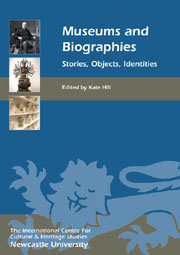Book contents
- Frontmatter
- Contents
- List of Illustrations
- Introduction: Museums and Biographies – Telling Stories about People, Things and Relationships
- INDIVIDUAL BIOGRAPHY AND MUSEUM HISTORY
- PROBLEMATISING INDIVIDUALS' BIOGRAPHIES
- 4 ‘His Best Successor’: Lady Eastlake and the National Gallery
- 5 Women, Museums and the Problem of Biography
- 6 A Curatocracy: Who and What is a V&A Curator?
- INSTITUTIONAL BIOGRAPHIES
- OBJECT BIOGRAPHIES
- MUSEUMS AS BIOGRAPHY
- MUSEUMS AS AUTOBIOGRAPHY
- Endpiece: The Homunculus and the Pantograph, or Narcissus at the Met
- List of Contributors
- Index
6 - A Curatocracy: Who and What is a V&A Curator?
from PROBLEMATISING INDIVIDUALS' BIOGRAPHIES
Published online by Cambridge University Press: 05 February 2013
- Frontmatter
- Contents
- List of Illustrations
- Introduction: Museums and Biographies – Telling Stories about People, Things and Relationships
- INDIVIDUAL BIOGRAPHY AND MUSEUM HISTORY
- PROBLEMATISING INDIVIDUALS' BIOGRAPHIES
- 4 ‘His Best Successor’: Lady Eastlake and the National Gallery
- 5 Women, Museums and the Problem of Biography
- 6 A Curatocracy: Who and What is a V&A Curator?
- INSTITUTIONAL BIOGRAPHIES
- OBJECT BIOGRAPHIES
- MUSEUMS AS BIOGRAPHY
- MUSEUMS AS AUTOBIOGRAPHY
- Endpiece: The Homunculus and the Pantograph, or Narcissus at the Met
- List of Contributors
- Index
Summary
INTRODUCTION
On 5 July 1989, at the opening of the Design Museum in London, the then Prime Minister, Margaret Thatcher, displayed an attitude to museum culture that was to revolutionise the future of such institutions in the United Kingdom. ‘I call it an Exhibition Centre and not a museum – a museum is something that is really rather dead’ (Thatcher 1989). Some months previously, the Victoria & Albert Museum (the V&A) had experienced a management revolution which became the focus for polarised debates about its meaning and the role of curators: as one curator expressed it in his oral history recording: ‘By separating knowledge, care of what the objects were from physical care of the objects, they were in effect planning to destroy the curatorial profession as I understand it’ (Curator 2-T19/09).
In recent times the term ‘curator’ has come to be adopted as a synonym for any activity that involves a selective form of organising, including not just objects but people, or even activities. For instance, the 2009 Deloitte ‘Ignite’ festival at the Royal Opera House was promoted as having been ‘curated’ by Time Out. Publicly funded museum curators, however, have a distinctive professional identity and expertise that this chapter explores by drawing on V&A curators' oral life history recordings. My neologism ‘curatocracy’ points to two aspects of their identity: their status as professionals in a museum which proclaims on its website to be ‘the world's greatest museum of art and design, with collections unrivalled in their scope and diversity’; and the origin of their role as government civil servants.
- Type
- Chapter
- Information
- Museums and BiographiesStories, Objects, Identities, pp. 87 - 100Publisher: Boydell & BrewerPrint publication year: 2012

